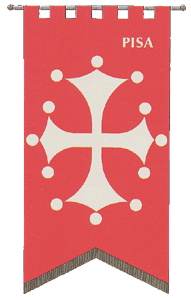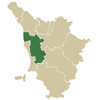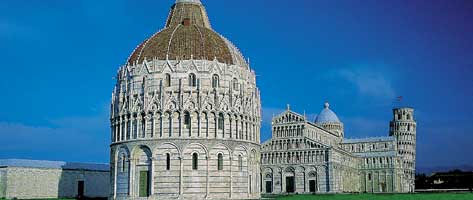|  Inhabitants in 1991: 98.928
Inhabitants in 1991: 98.928
 The
municipal territory extends for 187,08 square kilometres the capital and
situated on a bend of the river Arno 13 kilometres from its mouth.
Meeting point of important natural communication routes (Versilia,
Lucchesia, Valle di Collesalvetti and Valdarno Inferiore), it extends
in a large alluvial plain limited by the Tirreno sea to the west, the
Livornesi hills to the south, Monte Pisano to the east, and to the north
by the southern slopes of the Apuane Alpi and the lake of Massaciuccoli.
Constituted with the Leopoldine laws of the XVIII century, the
municipality underwent a territorial reduction in 1857 with the separation
of the district of Calci to become an autonomous municipality, while in
1927 it aggregated territory previously belonging to San Giuliano Terme. The
municipal territory extends for 187,08 square kilometres the capital and
situated on a bend of the river Arno 13 kilometres from its mouth.
Meeting point of important natural communication routes (Versilia,
Lucchesia, Valle di Collesalvetti and Valdarno Inferiore), it extends
in a large alluvial plain limited by the Tirreno sea to the west, the
Livornesi hills to the south, Monte Pisano to the east, and to the north
by the southern slopes of the Apuane Alpi and the lake of Massaciuccoli.
Constituted with the Leopoldine laws of the XVIII century, the
municipality underwent a territorial reduction in 1857 with the separation
of the district of Calci to become an autonomous municipality, while in
1927 it aggregated territory previously belonging to San Giuliano Terme.
The origins of Pisa are shrouded in legend, and its foundation
is attributed, from Roman history, either to the colonisation of Focesi
merchants, or to those of the Liguri, of whom there are archaeological
testimonies in various points on the Tirreno coast. The presence of
Etruscans is also uncertain, while from the II century B.C. Pisa was
tied in an alliance pact to Rome, as is shown by their participation in
the second Punic War (218 B.C.); from 180 B.C. it also became a
military colony, and was an important frontier stronghold and naval
base for the Roman fleet operating in the western Mediterranean. During
the Barbaric invasions, different from other centres which suffered
a heavy decline, Pisa seems to have substantially maintained its function
as Port, so that, before the conquest of Genova, it was the only Longobardo
dock in the high Tirreno. As in the Longobarda era, at the beginning
of the Carolingian era Pisa depended to the Duchy of Lucca, then
the major centre of power in the Tuscia; and it was only with the patronage
of Bonifacio, the Count and Duke of Lucca, that the Pisane ships participated
in the first great initiative of the town, the attack, in 828, of the
African coast. The second, less that fifty years later in 871, the Pisani
almost certainly constituted the most nurtured of the Toscani who successfully
defended Salerno from the Saracen assault. A third important initiative,
the expedition in Calabria, was brought to an end in 970.
In these times the city, from which emerged as institutional heads
the Bishop and the Viscount, already demonstrated a notable autonomy
and experienced a phase of strong growth, so much so that Liutprando da
Cremona (died 972) defined it as “head of the Tuscia province”.
Starting from the XI century it passed through one hundred years of
war, military expeditions and mercantile successes which would have contributed
to form the epic little town, Pisa was enforced as an autonomous seafaring
power extending and consolidating its domain with the penetration
into Corsica and Sardegna and with the expansion of its
markets and traffic towards the Arab world. In virtue of their
participation in the first Crusade it placed a solid base for its
commerce with the orient and North Africa, obtaining the concession
for the foundation of its own docks at Giaffa, Tiro and Ascalona and property
in the Holy Land, at Cario, Alessandria and Costantinopoli with warehouses,
churches and quartering autonomous rather than depending on the native
authorities. At the beginning of the XII century the Saracens were
definitively defeated at Baleari their last stronghold in the western
Mediterranean, and the economic and commercial supremacy was assured to
the southern Tirreniche city and in fact helping - even if not on a precise
agreement - the conquest of Palermo by the Normans.
These successes in the long run generated an inevitable conflict with
Genova, another important protagonist in the Italian maritime expansion,
which in the end would have produced disastrous results. With regard to
internal events the decade across the XI and XII centuries saw the first
gradual trace of that which would become the municipality. If the first
consul attestation was dated around 1084, it was in fact only after the
middle of the successive century, at the end of a period of cohabitation
between Bishop, Viscount, and consular aristocracy cemented by communal
economic interests, that the consuls (and the senate which was side by
side with them) assumed all the major political, fiscal and jurisdictional
attributions. Parallel to this evolutional institution was the outline
of a decisive penetration of the strength of the Ecclesiastic and Lay
townsfolk in the county territory – both in those near the town
and those further away, like Maremma south of the river Cecina –
and towards the end of the XI century the countryside appeared as a fairly
well organised complex subordinate to the city. This process was sanctioned
and in some way guaranteed by the Emperor: in 1162 Federico Barbarossa,
in exchange for the support of Pisa for his Italian politics, recognised
their jurisdiction over all the county and the Tirreno coast from Portovenere
to Civitavecchia, while three years later assured the feudalisation
of Sardegna which damaged Genova. This was reason enough for restarting
the conflict with the Ligure republic, complicated by the involvement
of other Toscana cities: Firenze intervened beside Pisa, Lucca
and Siena allied themselves with Genova. With the coronation of Federico
II, however, the political formation of Toscana, under the pretext
of the adhesion or the opposition by the Imperial party, but in reality
with moves of precise interest and for motives of prestige it was recomposed
on a different basis: on one side the “Guelfi”, with at their
head the Fiorentini who had broken their alliance with Pisa and
taken up with Lucca, on the other the "Ghibellini" supported
by Pisa and Siena. The decade which followed was for Pisa, surrounded
by many enemies, more shadow than light. Defeated for the first time in
1222 at Casteldelbosco, lost in 1254 the Lunigiana, the Versilia, the
Valdarno, the Vald’Era and the Val di Serchio were reconquered
only after the thrashing of the Fiorentini at Montaperti in 1260, which
opened a brief period of peace, followed however immediately after
by the resumption of hostilities and the new defeat of Pisa.
To their defeat in 1275 at Montopoli was added in 1284 the decisive victory
by Genova at Meloria which decreed the end of Pisa’s dominance
over the Mediterranean. The impact of the these external events made
the internal difficulties even more acute to the managing classes
evidenced in the first instant by the tormented passage from the consular
regime to that of the Podesta (more often than not an outsider), then
from the collision between the “nobility” and the new forces
grouped under the label of “peoples”: conflicts being
put into order again only towards the end of the 1200s, thanks to the
compromise which excluded from political power both the nobility entrenched
in the conservative position, and the populace and wage earners. The
1300s opened for Pisa with a favourable phase, coinciding with the
presence in Italy of Arrigo VII of Lussemburgo: this reiterated vigour
to the Ghibellino party which under the leadership of Uguccione della
Faggiola, made Lord of Pisa and therefore of Lucca, overwhelmed the
Guelfa league at Montecatini in 1315. But not this victory nor the peace
of Montopoli in 1329 ended the controversy between the Toscane city and
after the fall of the Donoratico family’s Lordship (1347) Pisa,
which had again acquired dominion over Lucca in 1342, found itself squashed
between Fiorentini pressure, by now determined to conquer at outlet
to the sea, and that of the Milano Visconti, interested in expanding
into Toscana. In 1399 Gherardo d’Appiano, Lord of the city,
sold it to the Duke of Milano, who a few years later ceded it to the Fiorentini.
After a final rebellion which occupied the Firenze troops for many months,
Pisa surrendered in 1406 and, with the exception of brief periods of freedom
(1494-1509) obtained with the protection of Carlo VIII, remained subjugated
to the Lilied City knowing, at least until the late 1400s a period
of demographic decline and economic decadence.
The resurgence was due to the more balanced politics of the Fiorentini
government in the 1500s: in 1543 the university, of ancient tradition
but inactive since 1505, was reopened, while from the second
half of the XVI century notable public works were realised, among
which stands out the aqueduct by order of Ferdinando I dei Medici, the
Two Mast Coaster canal connection to Livorno and the surrounding marsh
land drainage. Distant from the splendour of the XII and XIII centuries,
and forced into a subservient role, Pisa however remains in modern time
the major cultural Toscana centre, celebrated above all for the
scientific school, which after the teaching of Galileo maintained
its fame high in Europe. In the Fascist period its university,
which already during the Risorgimento had shaped an idea of patriotism
and democracy, was, together with the parties which in 1943 formed the
antifascist Front (successively transformed In Committee of National Liberation),
the propulsion centre of an active clandestine activity. As this
important strategic junction, Pisa suffered grave damage during
the war: first from the bombardments and then for 45 days the Front
being stopped in the city, on the line of the Arno provoked 1824 victims
and the total or partial destruction of almost half the houses, the industrial
plants and many artistic buildings (the Camposanto, the bridges, the embankments).
Among Pisa’s illustrious: the mathematician Leonardo Fibonacci
(XII-XIII), sculptor and architect Giovanni Pisano (1248-1318),
Galileo Galilei (1564-1642), physicist Antonio Pacinotti
(1841-1912).
 The present-day layout of Pisa is more or less as it was in the
Lorraine period, though many new buildings were erected after the heavy
bombing of the city in 1944, which destroyed almost half the buildings
in the city.
The religious heart of the city is somewhat off-centre and is a
rather particular environment. Set on a green lawn, Piazza Dei Miracoli
embodies the whole span of human existence: birth is represented by the
Baptistery, the Tower symbolises the attainment of reason, the
Cathedral that of sanctity, and death is represented by the Camposanto.
The Museo dell'Opera del Duomo was inaugurated in the Piazza dei
Miracoli in 1986; works housed here include a 12th century wooden Christ
figure and various treasures from the Duomo.
Near Corso Italia there is Palazzo Mastiani, which now houses the university's
Faculty of Computer Science.
The city's prestigious university, which is world-renowned for its research,
has helped to make Pisa one of the major cultural centres
in Italy.
During excavation work in 1998 for the construction of a building for
the railways, a number of interesting finds came to light, which will
be housed in the Museo del Mare, due to open in 2002. What was
found was the "Porto delle Meraviglie" (the "port of wonders"):
complete with their cargoes, 18 ships from different eras have remained
virtually intact for centuries under metres of earth.
It's thought that these ships were sunk in various storms during the period
when Pisa was still on the coast.
The typical gastronomic specialities of Pisa are fish-dishes:
stoccafisso con le patate (dried cod with potatoes), torta con
le acciughe (anchovy pie), anguille con i piselli (eels with
peas), and the famous cee (eel fry) cooked in various ways. On
All Saints' Day, it is customary to taste the traditional Torta co'
Bischeri, a pie that can be either sweet or savoury.
If you visit Pisa on the 16th or 17th of June you will catch two important
folklore events. On the 16th there is the Regata delle Repubbliche
Marinare, a race between the fabulous ships of the ancient maritime
republics of Genoa, Amalfi, Venice, and Pisa, which takes place on the
Arno. There is another regatta the next day in honour of the patron saint
of the city, San Ranieri, culminating in a party to celebrate the
winner of the previous day's race.
Places to visit:
Piazza of Miracles, where the religious centre of the city
is concentrated. In this green area the human existence is represented
by the four white buildings: The Baptistery (baptism), the Tower (reason),
the Cathedral (health) the Cemetery (death).
The Baptistery, majestic Romanic building, to which a rich
Gothic decoration was successively added. Started in 1152 on the plans
of Diotisalvi, it was finished more than a century later. The rich
interior preserves a splendid marble pulpit by Nicola Pisano.
The Tower, started by Bonanno Pisano in 1173 and finished in
1350 by Tommaso Pisano. This particular cylindrical structure considered
a miracle of static for its tilt (ascertained during its construction)
is still standing. Closed to the public for some years, because of
consolidation works, and recently reopened.
The Cathedral, placed in the centre of the square and dedicated
to the Virgin Assunta, it is a masterpiece of Romanic Pisana architecture.
Started in 1064 by architect Buscheto it was consecrated by Pope Gelasio
II in 1118. In the successive centuries it has been enlarged. It was
restored after the fire in 1595 and in the 1800s. The Latin Cross
interior is divided in five naves and contains innumerable and precious
works of art.
The Cemetery. This huge rectangular gallery closes the northern
side of the piazza. According to legend the land enclosed here was
transported from Monte Golgota by the Pisani who fought the crusades
of 1203. The building was initiated in 1277 and finished after more
than a century. The interior is covered with frescos (many devastated
by the bombardment of the last war) among which stands out the 1300s
complex (attributed to Buffalmacco) figuring the Guidizio Universale,
l’Inferno, il Trionfo della Morte (Universal Judgment, the Underworld,
the Triumph of Death) It preserves precious Roman sarcophagus, ancient
funeral stones and sepulchres of important Pisane families.
Cathedral Works Museum, with Seat of the Canonic Palace on
the eastern side of the Piazza dei Miracoli, collection of works from
the buildings of the square together with Etruscan and Roman antiquity,
and Egyptian finds. Interesting is the Treasure room and the silver
room.
Piazza dei Cavalieri, built for Cosimo I and designed by Vasari,
it is one of the most scenographic urban realisations of the time.
The elegant Palazzo dei Cavalieri faces onto it, now the Seat
of the University High School, established by Napoleone. On the left
of the Palazzo dei Cavalieri is found the Palazzo dell’Orologio,
or della Gherardesca, designed in 1565 by Vasari and realised in 1605
uniting two already existing towers. In one of these in 1289 Count
Ugolino met his death with his sons (remembered by Dante in a Canto
dell inferno). Another church faces onto the same square, the church
of S. Stefano dei Cavalieri, designed by Vasari and erected
on the place of a preceding Medieval church. The single nave interior
preserves an original collection of ancient flags, for the most part
Turkish, as testimony to the Pisani conquests in the Orient.
New Fort, positioned south of the course of the Arno, it was
erected in 1468 by the Fiorentini as a sign of its superiority. The
fort was reconstructed in 1512 by Giuliano da Sangallo and even today
the remains of Bastione Sangallo can be seen.
National Museum of San Matteo, ex Benedictine Monastery placed
on Lungarno(banks of the Arno) Mediceo restored and adapted as Museum
Seat, in which the Pisana Art is completely represented.
Domus Galileiana, instituted in 1942 as centre of Galileiani
studies, there are books and relics of the celebrated Pisano scientist
conserved there.
Santa Maria della Spina, church erected in 1323 in Gothic style,
it has a thorn from Christ’s Crown as relic.
Church of Santo Sepolcro from 1153. with its original octagonal
plan, preserves internally a precious Madonna con Bambino by Benozzo
Gozzoli. |
Historical info reproduced upon authorization of
Regione Toscana - Dipartimento della Presidenza E Affari Legislativi e
Giuridici
Translated by Ann Mountford
Picture by Sandro Santioli |